The Origins of Rich High School
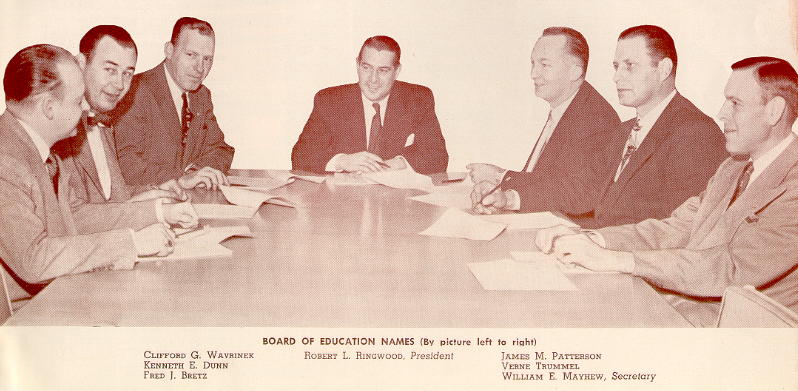
The Hardworking and Visionary Early School
Board Members.
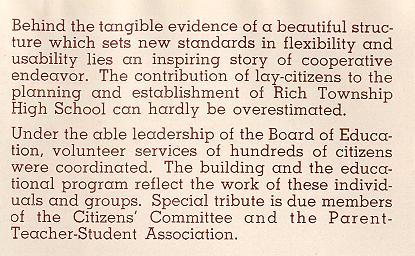
The Architect: Loebl, Schlossman and Bennett
Architects and Engineers, Chicago, Illinois
The Contractor: Chell and Anderson,
General Contractors, Chicago, Illinois
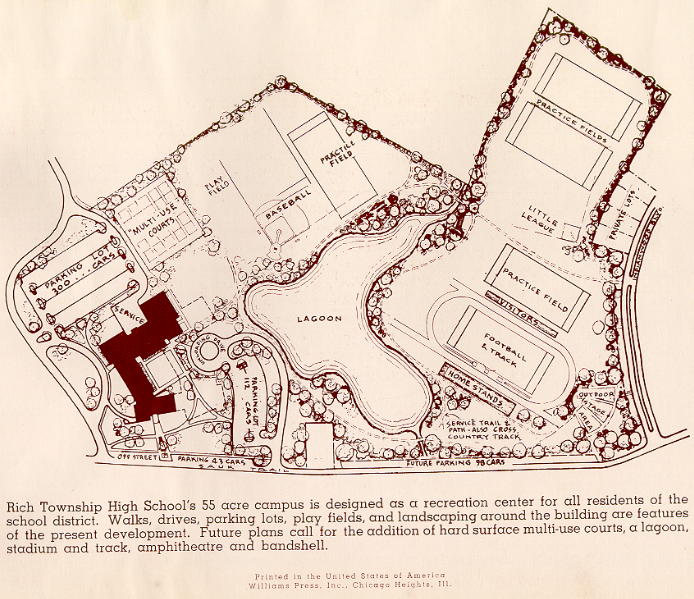
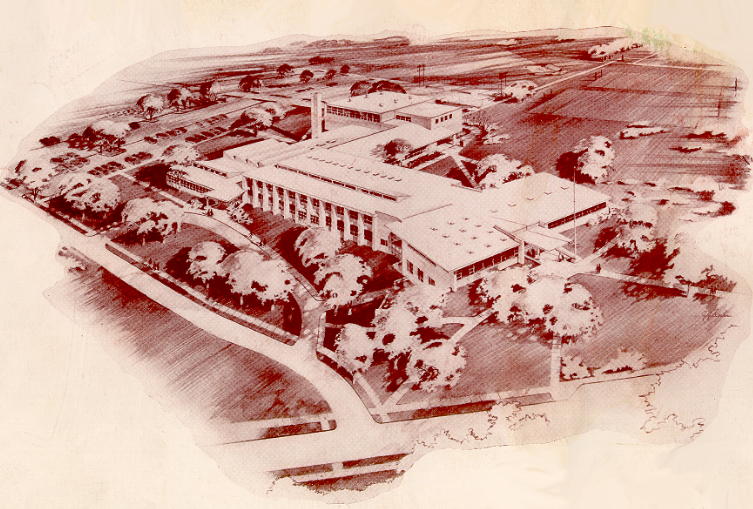
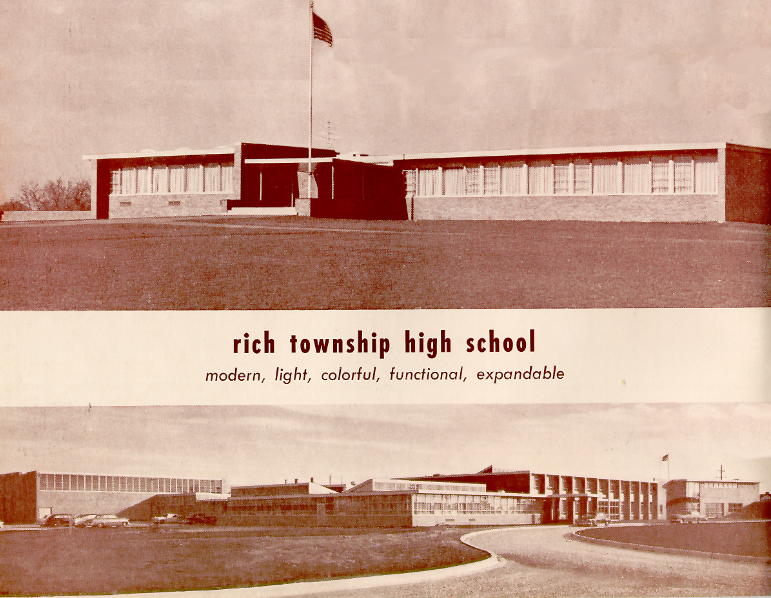
The photos and drawings above appeared in a
brochure mailed out to residents and also used for promotional purposes
by the High School District and the Village
of Park Forest, probably in early 1954.
(There are no copyrights or copyright dates.)
The brochure was entitled "Rich Township High
School, Park Forest, Illinois."
It was printed in the United States of America
by the Williams Press, Inc., Chicago Heights, Ill.
The photographers listed were Gibson Studios,
Chicago, Illinois, and Bernard Klein, Park Forest, Illinois.
The Park Forest Public Library also has several
of these brochures in its Local History collection. See a link
to the Park Forest Public Library on the LINKS
page below.
Following is a summary of the beginning of
Rich Township High School, based on an Oral History transcript by James
M. Patterson for the Park Forest Public Library's Oral History Project,
and used with permission from the Park Forest Public Library. Mr. Patterson
was interviewed in December of 1980 over a span of several recording sessions.
James Patterson moved to Park Forest in the
fall of 1948 to live in a rental unit at 2818 Western Avenue, Court E7.
As the elected court representative, he participated in early discussions
on what to name the community, and whether it should be a village, or incorporated
as a town. He opposed the name “Sauk Town,” and was active in the fight
to name Park Forest, Park Forest.
The President of the Community Council, Robert
Dinerstein, asked Patterson to serve on the high school committee and he
accepted. At that time when there was no high school in Park Forest and
children from surrounding communities were sent on a tuition basis to Bloom
or Thornton high schools. The Park Forest area was known as “Cook County
[school district] Non-High,” which meant that taxes were paid for no services.
The Committee pulled out of the Cook County Non-High and formed Rich Township
High School District #227. The tax rate was halved, saving American Community
Builders thousands of dollars since they owned the land.
With the rapid growth of the community in those
days, they realized that it would be necessary to build a high school in
Park Forest. At some point, Patterson asked the Bloom Township High School
Board if they would build a high school in Park Forest, and have District
227 be attached to Bloom’s District. The response was, “No, there’ll never
be but one Bloom.” They accepted to build a junior high school, but no
high school. The oral history is not clear on just when the meeting occurred,
but it probably took place around the time of the election of the first
school board.
With the District formed, the first election
of five members for the Board of Education were held on April 5, 1949.
Patterson was elected as the representative of Park Forest. At that time,
the village had only 71 registered voters. (Many recent arrivals had not
yet changed their voting residence.) In view of the District population
at that time, the other members of that first Board were elected from nearby
communities. They were:
R. L. Ringwood, Olympia Fields, who was elected
President of the Board.
Robert St. Pierre, Matteson, whom the Board
named as Secretary.
Clifford Wavrinek, Matteson
Jack Abrahams, Flossmoor
James M. Patterson, Park Forest
The initial Board had no professional employees.
They expected rapid growth of the community (to 30,000 people), so they
quickly commissioned a feasibility study for a high school, to be prepared
by Dr. Lawler of Northwestern University. The Lawler Report recommended
that a high school should be built and suggested a site on 211th street.
But there was a site south of the shopping center (the Plaza), along Indianwood
and extending to Sauk Trail, which had not been developed and whose central
location appealed to the Board. The area was popular with many village
children who called the site “The Swamp” since part of it was full of ponds
and cattails, frogs, turtles and snakes.
Mr. Patterson went to Mr. Klutznick, of American
Community Builders, with the argument that the site was not adequate for
ACB to develop and said, “Since you aren't going to develop it, why don't
you give it to us and get it off the tax rolls?” Mr. Klutznick accepted
the request and sold the School Board a 40-acre site on the northwest corner
of Indianwood Boulevard and Sauk Trail for one dollar. Later, when the
architect's plans for the high school building were prepared, exploratory
borings did show that the land near Indianwood and the Sauk Trail intersection
contained too much peat moss to support the building. The problem was solved
when Patterson asked Mr. Klutznick for more land on the Westwood side of
the site, and received an additional 16 acres which could be built on.
The plans were altered and it was built with the side designed to face
Indianwood facing Westwood instead. The Indianwood side of the site was
then designated for sports fields. Some years later, three acres were sold
back to ACB for a parking lot for the Jewel store. The price was $50,000.
With the feasibility study and a site, the
Board had to obtain funds to build the high school, and a bond referendum
was scheduled for June in 1951. But before that time, the Board had been
reduced to three members, as Flossmoor decided to leave the district, and
later Mr. St. Pierre of Matteson resigned. The remaining three-man Board
had to reach decisions unanimously for them to be legal. This problem was
later resolved by the appointment of William E. Mayhew to fill the post
left vacant by the resignation of Jack Abrahams [and to replace Bob St.
Pierre. Other changes to the Board were perhaps due to new elections].
They enlisted a large group of 104 volunteers
to prepare for the vote, for the Board was concerned about apathy of people
who did not believe they would remain in Park Forest long enough for their
children to enter high school. The campaign and the volunteers were effective,
and the referendum passed by a 4 to 1 margin, despite being defeated in
some non-Park Forest parts of the Township.
When the Board received the estimates for the
school they wished to build, costs exceeded the amount approved in the
referendum by $350 000. They wanted the best in physical facilities, and
instead of cutting back on the program, the Board reactivated the volunteers,
and went back to the voters in the fall for an additional bond issue. That
second referendum passed in every precinct of the Township. Shortly after
that victory, the Board hired its first employee, Eric R. Baber. He was
hired as the high school's first Superintendent. Until that referendum
victory, everything had been done by volunteers.
Work quickly began on the site, and the new
high school was scheduled to open its doors to students in September, 1953.
However, the Board and new Superintendent were soon confronted with a major
problem: Bloom informed them that there was no room for all the Rich Township
freshmen that were expected to start high school in September, 1952. Work
immediately started on hiring teachers and finding facilities for a first
year of high school with the class of 1956, even before a school had been
built. A staff of 10 teachers was hired, plus a business manager who served
as Athletic Director and gym teacher during that first year. The school
program was developed, and all the procedures necessary for a school's
operations were established in record time.
The Faith United Protestant Church meeting
building, used for Sunday school, was rented, and the process of obtaining
accreditation from the North Central Association was started. The quality
of the program was such that RTHS was fully accredited in its very first
year, well before the new building was completed. The school opened with
a little over 120 freshmen.
That class graduated as the first four-year
class in 1956, and they showed the results of a strong academic program.
The Class of 1956's average achievement scores ranked in the top one percent
of the nation. By the time they graduated, Rich High had been selected
by educators as one of the three top schools in the entire middle west.
Three-fourths of the Class of 1956 went on to college. That is an outstanding
achievement.
CLICK HERE TO READ ABOUT THE DEDICATION
OF THE FIRST HIGH SCHOOL
CLICK HERE TO READ ABOUT THE ALL-AMERICA
CITY AWARD IN 1954.
CLICK HERE TO READ WHEN RICH TOWNSHIP HIGH
SCHOOL ADDED ANOTHER HIGH SCHOOL
RETURN TO HOME PAGE INDEX
All World Rights Reserved. Copyrighted ©2002-2003, Rich Township
High School Class of 1956




